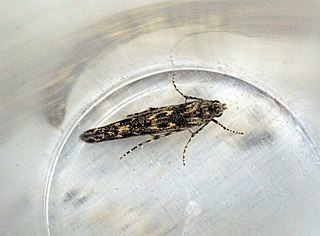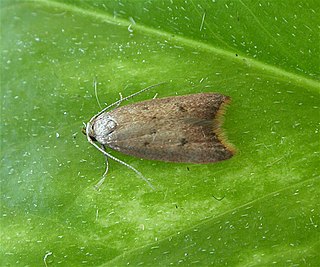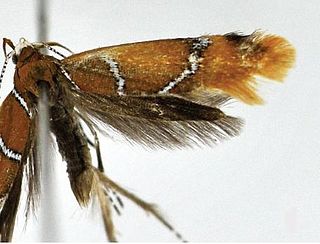
The Gelechiidae are a family of moths commonly referred to as twirler moths or gelechiid moths. They are the namesake family of the huge and little-studied superfamily Gelechioidea, and the family's taxonomy has been subject to considerable dispute. These are generally very small moths with narrow, fringed wings. The larvae of most species feed internally on various parts of their host plants, sometimes causing galls. Douglas-fir (Pseudotsuga) is a host plant common to many species of the family, particularly of the genus Chionodes, which as a result is more diverse in North America than usual for Gelechioidea.

Gelechioidea is the superfamily of moths that contains the case-bearers, twirler moths, and relatives, also simply called curved-horn moths or gelechioid moths. It is a large and poorly understood '"micromoth" superfamily, constituting one of the basal lineages of the Ditrysia.

The Batrachedridae are a small family of tiny moths. These are small, slender moths which rest with their wings wrapped tightly around their bodies.

Batrachedra is the largest genus in the moth family Batrachedridae, with representatives all over the world. The early stages of most species are unknown. The genus name is derived from the Greek words batrachos, 'frog', and edra, 'seat', referring to the frog-like resting posture of the adult moths. As of 2018 at least some 114 species are known to belong to the genus.

Spilomelinae is a very species-rich subfamily of the lepidopteran family Crambidae, the crambid snout moths. With 4,135 described species in 344 genera worldwide, it is the most speciose group among pyraloids.

The Plutellidae are a family of moths commonly known as the diamondback moths, named after the diamondback moth of European origin. It was once considered to have three subfamilies: Plutellinae, Praydinae, and Scythropiinae. Praydinae was later elevated to its own family, Praydidae, while Scythropiinae has variously been moved to Yponomeutidae or also elevated to its own family.

Anacampsis is a worldwide genus of moth with most found in the nearctic and neotropical regions. It is in the family Gelechiidae. The larvae feed on a range of deciduous trees and shrubs in a rolled or folded leaf, or spun shoot.

Tachystola acroxantha is a moth of the family Oecophoridae. It is native to Australia, but is an invasive species in New Zealand and Europe, probably imported with Australian plants.

Macrobathra is a genus of moths in the family Cosmopterigidae. Most species are endemic to Australia.

The Depressariinae – sometimes spelled "Depressiinae" in error – are a subfamily of moths in the superfamily Gelechioidea. Like their relatives therein, their exact relationships are not yet very well resolved. It has been considered part of family Elachistidae sensu lato or included in an expanded Oecophoridae. In modern classifications they are treated as the distinct gelechioid family Depressariidae.

Idioglossa is a genus of moths of the family Batrachedridae.

Agonopterix is a moth genus of the superfamily Gelechioidea. It is placed in the family Depressariidae, which was often – particularly in older treatments – considered a subfamily of the Oecophoridae or included in the Elachistidae.

Autosticha is a genus of gelechioid moths. It belongs to the subfamily Autostichinae, which is either placed in the concealer moth family (Oecophoridae), or in an expanded Autostichidae. It is the type genus of its subfamily. Originally, this genus was named Automola, but this name properly refers to a fly genus in family Richardiidae.

Xyloryctidae is a family of moths contained within the superfamily Gelechioidea described by Edward Meyrick in 1890. Most genera are found in the Indo-Australian region. While many of these moths are tiny, some members of the family grow to a wingspan of up to 66 mm, making them giants among the micromoths.

Promalactis is a genus of moths of the family Oecophoridae.

Prepalla austrina is a moth of the family Oecophoridae. It was described by Edward Meyrick in 1914 under the name Saropla austrina. Meyrick later moved the species into the genus Oxythecta. However in 1997 its taxonomy was reconsidered by Ian Francis Bell Common and the species was included in the genus Prepalla. It is endemic to New Zealand and is present in Otago. The host plant for this moth is Leucopogon fraseri.

Asaphodes abrogata is a moth in the family Geometridae. It is endemic to New Zealand and can be found from the central North Island as well as the South Island. This species is inhabits open country at altitudes of between 2000 and 4000 ft. Larvae have been reared on Plantago species including Plantago coronopus. It has been recommended that Plantago raoulii be planted to attracted this species. Adults are on the wing in February and March.

Hierodoris stella is a species of moth in the family Oecophoridae. This species is endemic to New Zealand and occurs in Auckland, Taranaki, Hawkes Bay, Bay of Plenty and Wellington. As at 2005 the larvae of this species is unknown as is its host plant. The adult moth frequents forest and are on the wing in January and February. It is classified as "At Risk, Relict'" by the Department of Conservation.

Tachystola hemisema is a moth of the family Oecophoridae. It is native to Australia, but is an invasive species in New Zealand and the United States, probably imported with Australian plants.


















